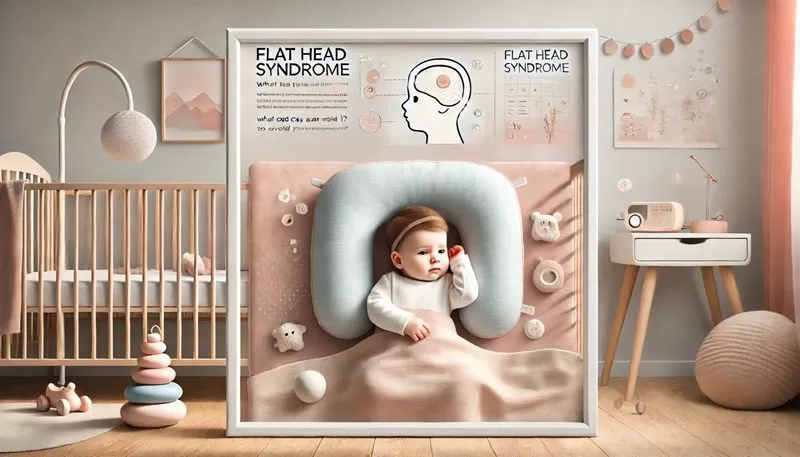Table of Contents
Flat Head Syndrome Babies
Flat Head Syndrome (Positional Plagiocephaly) is a condition that occurs when a baby’s head develops a flat spot due to prolonged pressure on one side. It’s something that many parents worry about, especially during the first few months when babies spend most of their time lying down. But with a little knowledge and some proactive steps, you can easily avoid or correct this condition. In this guide, we will explain flat head syndrome, its causes, and—most importantly—how to prevent flat head syndrome in babies. Additionally, we’ll recommend some of the top products from our store to help you along the way.
Flat head syndrome, also known as positional plagiocephaly, occurs when a baby’s head develops a flat spot due to prolonged pressure on one area. While it’s common and treatable, early intervention is key to preventing long-term effects. To better understand this condition and the methods to prevent it, you can explore how to prevent flat head syndrome in babies on a trusted resource provided by the American Academy of Pediatrics. Implementing simple changes in a baby’s routine can greatly reduce the likelihood of developing flat spots.
What is Flat Head Syndrome (Positional Plagiocephaly)?

Flat Head Syndrome (Positional Plagiocephaly), also known as positional plagiocephaly, is a common condition that affects infants when they spend too much time lying in one position. Since a baby’s skull is still soft and moldable, prolonged pressure on one area can lead to a flat spot on the back or side of the head. This often happens within the first few months of life when babies are too young to reposition themselves.
Parents often notice this flattening as their baby begins to grow, and although it may seem alarming, the condition does not impact the baby’s brain development. In fact, with early intervention, flat head syndrome can often be corrected.
Sleep deprivation is a common challenge for new parents, but it’s important to prioritize your rest to stay healthy and alert. Establishing a consistent bedtime routine for your baby can help improve their sleep, and by extension, yours. Creating a calm, soothing environment with dim lighting, gentle music, and a comfortable sleeping space can also make a big difference. If you’re finding it tough to get through the day, don’t hesitate to ask for help—whether it’s from your partner, family, or friends. You can also check out our article, How to Deal With Sleep Deprivation After Baby for more detailed strategies and tips to help you manage this new phase of life.
Causes of Flat Head Syndrome in Babies

Several factors can contribute to flat head syndrome, and understanding these causes can help you prevent it. Below are some of the most common contributors to Flat Head Syndrome (Positional Plagiocephaly):
- Sleeping Position: The most significant cause of flat head syndrome is a baby’s sleep position. Babies who sleep on their backs for extended periods may develop flattening on the part of the head that rests on the mattress.
- Limited Tummy Time: Tummy time is essential for developing strong neck and shoulder muscles. Without enough tummy time, babies spend most of their day lying on their backs, which increases the likelihood of flat head syndrome.
- Premature Birth: Premature infants are more susceptible to flat head syndrome because their skulls are softer, and they spend more time in NICU incubators or lying down.
- Torticollis: Some babies have a condition called torticollis, where the neck muscles are tight on one side, causing them to consistently turn their head in the same direction, which can lead to flat head syndrome.
- Overuse of Car Seats, Bouncers, and Swings: While convenient, too much time in baby gear that holds your child in the same position can increase pressure on the back of their head.
How to Prevent Flat Head Syndrome in Babies

The good news is that flat head syndrome is preventable. By incorporating simple changes into your baby’s daily routine, you can significantly reduce the chances of developing flat head syndrome.
1. Start Tummy Time Early and Often
Tummy time is crucial for your baby’s physical development and is one of the best ways to prevent flat head syndrome. Tummy time strengthens your baby’s neck, shoulders, and back muscles, which helps them gain more control over their head movements.
You can start tummy time as soon as your baby’s umbilical cord falls off, and gradually increase the duration as your baby gets older. If your baby seems resistant at first, try doing tummy time for short bursts throughout the day, gradually extending the time.
For a more engaging tummy time, try using our Tummy Time Play Mat. This mat is designed with stimulating toys and textures to encourage your baby to stay on their tummy longer while promoting head and neck strength.
2. Alternate Your Baby’s Head Position During Sleep
Many parents don’t realize that a baby’s head position during sleep plays a significant role in preventing flat head syndrome. By alternating the direction your baby’s head faces each night, you can prevent consistent pressure on one side of the skull.
For additional support, consider using our Ergonomic Baby Pillow, which is designed to gently cradle your baby’s head while allowing for safe and comfortable movement. This pillow helps keep your baby’s head in alignment and reduces the likelihood of developing flat spots.
3. Minimize Time in Car Seats and Swings
While it’s tempting to rely on baby swings, bouncers, and car seats for convenience, they can contribute to the development of flat head syndrome if your baby spends too much time in them. These devices put pressure on the same part of the baby’s head, especially if used for extended periods.
Instead of relying solely on these devices, try using a baby carrier that keeps your baby in an upright position. The Comfort Baby Carrier from our store is an excellent option, as it evenly distributes your baby’s weight and helps avoid prolonged pressure on their head.
One of the most frustrating challenges for parents is dealing with diaper blowouts and leaks, which can create a mess and cause discomfort for your baby. Choosing the right diaper size and ensuring a snug fit can greatly reduce the chances of leaks, especially during nap times and outings. Consider using products like leak-proof diapers and diaper covers to add an extra layer of protection. Additionally, frequent diaper changes and using highly absorbent products can help prevent skin irritation and rashes caused by prolonged wetness. For more helpful tips on Managing Diaper Blowouts and Leaks, check out our diaper essentials collection.
How to Prevent Flat Head Syndrome in Newborns: 8 Effective Ways

Here are 8 effective ways to prevent flat head syndrome in newborns, ensuring your baby’s head stays perfectly shaped:
1. Limit Time in Baby Gear
Avoid keeping your baby in swings, car seats, and bouncers for extended periods. Although they are convenient for parents, they contribute to flat spots if used excessively.
2. Increase Cuddle Time
Holding your baby upright, especially when awake, allows them to experience the world in different ways and reduces the time spent on their back.
3. Use a Baby Carrier
A baby carrier like the Comfort Baby Carrier promotes an upright position, which takes pressure off the head while allowing your baby to move freely.
4. Adjust Your Baby’s Sleep Position
Make small adjustments by placing your baby’s head in a different direction each night to avoid pressure on the same area of the head.
5. Engage Your Baby in Interactive Play
Encourage your baby to turn their head during playtime by placing toys on the side that they usually avoid. This encourages your baby to strengthen both sides of their neck and head.
6. Be Mindful of Feeding Positions
Switching sides during feeding can help ensure that your baby’s head isn’t always resting on the same side. If you bottle-feed, be sure to alternate arms.
7. Use Positional Aids
Products like the Ergonomic Baby Pillow provide added support, but they should be used as a supplement and not a replacement for regular repositioning.
8. Consult a Pediatrician if Necessary
If you notice persistent flattening or if your baby has a hard time moving their neck, it’s a good idea to consult a pediatrician. Early intervention can prevent long-term issues.
While flat head syndrome is a common concern among parents, it’s essential to be aware of other conditions that can affect newborns, such as jaundice. Jaundice in newborns is a condition that results in yellowing of the skin and eyes due to high levels of bilirubin. It is important to monitor the symptoms and seek medical advice if necessary. To learn more about the causes, symptoms, and treatment options, check out our detailed guide on Jaundice in Newborns – Symptoms, Causes, and Treatment
Flat Head Syndrome (Positional Plagiocephaly) Recap
To summarize, flat head syndrome is a condition caused by prolonged pressure on one part of the head, but it is preventable and treatable. By incorporating small changes such as increasing tummy time, switching your baby’s head position, and limiting time in baby gear, you can prevent your baby from developing a flat spot on their head.
Using supportive products like the Tummy Time Play Mat, Ergonomic Baby Pillow, and Comfort Baby Carrier can further help prevent flat head syndrome and ensure your baby’s head stays round and well-formed.
Conclusion: How to Prevent Flat Head Syndrome in Newborns: 8 Effective Ways
While flat head syndrome can be a concern for new parents, it is entirely preventable with the right strategies. Following the 8 effective ways to prevent flat head syndrome in newborns, including promoting tummy time, alternating sleep positions, and limiting time spent in baby gear, will help your baby develop a round, healthy head shape.
Remember to explore our store for products designed to support your baby’s development, such as the Tummy Time Play Mat, Ergonomic Baby Pillow, and Comfort Baby Carrier. These items can make a world of difference in your baby’s daily routine and provide peace of mind as you navigate these important first months.
How to travel with a baby, and the gear you need
Traveling with a baby requires a bit of preparation, but the right gear can make all the difference. To keep your baby comfortable and safe during long journeys, it’s essential to have a lightweight stroller, a comfortable baby carrier, and a travel-friendly crib. These items not only provide convenience but also ensure that your baby can rest in different environments, helping to prevent conditions like flat head syndrome. Additionally, a portable car seat with a supportive headrest is a must for protecting your baby’s delicate head during car rides. For air travel, consider using a baby travel pillow to provide added support during naps. Each of these items is designed with your baby’s comfort in mind, allowing for a smoother, stress-free travel experience for both parent and child. You can find these essentials and more at our store [link to your product pages].

